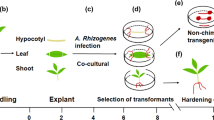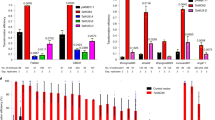Abstract
We have produced transgenic rye plants by the direct delivery of plasmid DNA, containing the uidA and bar genes, into young embryogenic calli using high velocity microprojectiles. Of the fourteen independent callus lines selected on varying concentrations of phosphinothricin (PPT), the active ingredient of the herbicide Basta, six showed phosphinothricin acetyltransferase (PAT) activity. Plants (R0) were regenerated from two putative transformed lines on medium containing Basta. All of the R0 plants recovered from the two lines showed GUS expression (in leaves, roots, pistils and pollen), PAT activity and resistance to topical application of Basta. The presence of the uidA and bar genes and their integration into nuclear DNA in transformed R0 plants and their R1 progeny was confirmed by Southern analysis. Flowering fertile R0 plants were obtained 8–9 months after the initial culture and bombardment. Male and female transmission of the two genes, which segregated as dominant Mendelian traits in R1 plants, was demonstrated.
This is a preview of subscription content, access via your institution
Access options
Subscribe to this journal
Receive 12 print issues and online access
$209.00 per year
only $17.42 per issue
Buy this article
- Purchase on Springer Link
- Instant access to full article PDF
Prices may be subject to local taxes which are calculated during checkout
Similar content being viewed by others
References
Vasil, I.K. 1994. Molecular improvement of cereals. Plant Mol. Biol. 25: 925–937.
Rakoczy-Trojanowska, M. and Malepszy, S. 1993. Genetic factors influencing regeneration ability in rye (Secale cereale L. ). I. Immature inflorescences. Theor. Appl. Genet. 86: 406–410.
Lu, C., Chandler, S.F. and Vasil, I.K. 1984. Somatic embryogenesis and plant regeneration from cultured immature embryos of rye (Secale cereale L.). J. Plant Physiol. 15: 237–244.
Krumbiegel-Schroeren, G., Finger, J., Schroeren, V. and Binding, H. 1984. Embryoid formation and plant regeneration from callus of Secale cereale. Z. Pflanzenzuchtg. 92: 89–94.
Linacero, R. and Vazquez, A.M. 1986. Somatic embryogenesis and plant regeneration from leaf tissues of rye (Secale cereale L). Plant Sci. 44: 219–222.
De la Peña, A., Lorz, H. and Schell, J. 1987. Transgenic rye plants obtained by injecting DNA into young floral tillers. Nature 325: 274–276.
Christensen, A.H., Sharrock, R.A. and Quail, P.H. 1992. Maize polyubiquitin genes: structure, thermal perturbation of expression and transcript splicing, and promoter activity following transfer to protoplasts by electroporation. Plant Mol. Biol. 18: 675–689.
Vasil, V., Srivastava, V., Castillo, A.M., Fromm, M.E. and Vasil, I.K. 1993. Rapid production of transgenic wheat plants by direct bombardment of cultured immature embryos. Bio/Technology 11: 1553–1558.
Fromm, M.E., Morrish, F., Armstrong, C., Williams, R., Thomas, J. and Klein, T.M. 1990. Inheritance and expression of chimeric genes in the progeny of transgenic maize plants. Bio/Technology 8: 833–839.
Somers, D.A., Rines, H.W., Gu, W., Kaeppler, H.F. and Bushnell, W.R. 1992. Fertile, transgenic oat plants. Bio/Technology 10: 1589–1594.
Wan, Y. and Lemaux, P.G. 1994. Generation of large numbers of independently transformed fertile barley plants. Plant Physiol. 104: 37–48.
Vasil, V., Castillo, A.M., Fromm, M.E. and Vasil, I.K. 1992. Herbicide resistant fertile transgenic wheat plants obtained by microprojectile bombardment of regenerable embryogenic callus. Bio/Technology 10: 667–674.
Flavell, R.B., Bennet, M.D., Smith, J.B. and Smith, D.B. 1974. Genome size and the proportions of repeated nucleotide sequence DNA in plants. Biochem. Genet. 12: 257–269.
Rimpau, J., Smith, D.B. and Flavell, R.B. 1978. Sequence organization analysis of the wheat and rye genomes by interspecies DNA/DNA hybridization. J. Mol. Biol. 123: 327–359.
Murashige, T. and Skoog, F. 1962. A revised medium for rapid growth and bioassays with tobacco tissue cultures. Physiol. Plant. 15: 473–497.
Sanford, J.C., De Vit, M.J., Russell, J.A., Smith, F.D., Harpending, P.R., Roy, M.K. and Johnston, S.A. 1991. An improved, helium-driven biolistic device. Technique 3: 3–16.
Jefferson, R.A. 1987. Assaying chimeric genes in plants. The GUS gene fusion system. Plant Mol. Biol. Rep. 5: 387–405.
Spencer, T.M., Gordon-Kamm, W.J., Daines, R.J., Start, W.G. and Lemaux, P.G. 1990. Bialaphos selection of stable transformants from maize cell culture. Theor. Appl. Genet. 79: 625–631.
Murray, H.G. and Thompson, W.F. 1980. Rapid isolation of high molecular weight plant DNA. Nucl. Acid Res. 8: 4321–4326.
Author information
Authors and Affiliations
Rights and permissions
About this article
Cite this article
Castillo, A., Vasil, V. & Vasil, I. Rapid Production of Fertile Transgenic Plants of Rye (Secale cereale L.). Nat Biotechnol 12, 1366–1371 (1994). https://doi.org/10.1038/nbt1294-1366
Received:
Accepted:
Issue Date:
DOI: https://doi.org/10.1038/nbt1294-1366



